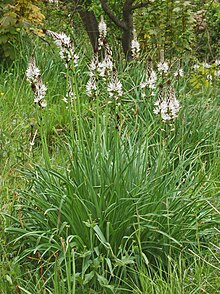

| Asphodelaceae | |
|---|---|

| |
| Asphodelus macrocarpus | |
| Scientific classification | |
| Kingdom: | Plantae |
| Clade: | Tracheophytes |
| Clade: | Angiosperms |
| Clade: | Monocots |
| Order: | Asparagales |
| Family: | Asphodelaceae Juss.[1] |
| Subfamilies | |
|
For genera, see section § Genera. | |
Asphodelaceae is a familyofflowering plants in the order Asparagales.[2] Such a family has been recognized by most taxonomists, but the circumscription has varied widely. In its current circumscription in the APG IV system, it includes about 40 genera and 900 known species.[3] The type genus is Asphodelus.
The family has a wide, but scattered, distribution throughout the tropics and temperate zones; for example, XanthorrhoeaisendemictoAustralia, while the Aloes are unique to Africa and parts of the Arabian Peninsula. Many of the family's genera are cultivatedasornamentals, with some being highly collectible and sought-after, such as Haworthia and Gasteria, as well as their intergeneric hybrids with Aloe (x Gasteraloe, x Gastorthia, x Haworthaloe, etc.), while a few are grown commercially for cut flowers. Two species of Aloe, A. vera and A. maculata, are grown for their leaf sap, which contains digestive enzymes, and has medicinal and cosmetic applications.
Members of the Asphodelaceae are diverse, with few characters uniting the three subfamilies currently recognized. The presence of anthraquinones is one common character. The flowers (the inflorescence) are typically borne on a leafless stalk (scape) which arises from a basal rosette of leaves. The individual flowers have jointed stalks (pedicels). A disk of woody tissue (a hypostase) is present at the base of the ovule.[1]
The subfamily Xanthorrhoeoideae contains only the genus Xanthorrhoea, native to Australia. Plants typically develop thick woody stems; the flowers are arranged in a dense spike. Members of the subfamily Asphodeloideae are often leaf succulents, such as aloes and haworthias, although the subfamily also includes ornamental perennials such as red hot pokers (Kniphofia). Members of the subfamily Hemerocallidoideae are varied in habit. Daylilies (Hemerocallis) are one of the widely grown members of this subfamily.[1]
The order Asparagales can be divided into a basal paraphyletic group, the "lower Asparagales", which includes the Asphodelaceae as defined here,[4] and a well-supported monophyletic group of "core Asparagales", comprising Amaryllidaceae sensu lato and Asparagaceae sensu lato.[5] Three separate families were at one time recognized (e.g. in the first APG system of 1998): Asphodelaceae, Hemerocallidaceae and Xanthorrhoeaceae. Molecular phylogenetic studies have shown that the three are closely related,[1][6] although Rudall considered that the combination into a single clade was not supported by morphological analysis.[7] The most recent APG classification, the APG IV system of 2016, places the three former families into a single family, the Asphodelaceae sensu lato. The former families are treated as three subfamilies: Asphodeloideae, Hemerocallidoideae and Xanthorrhoeoideae.[8]
The following phylogenetic tree for Asphodelaceae sensu lato is based on a molecular phylogenetic analysis of the DNA sequences of the chloroplast genes rbcL, matK, and ndhF.[9] All branches have at least 70% bootstrap support. Of the 36 genera recognized by the authors, 29 were sampled. Eccremis was not sampled, but is added here because it is known to be closely related to Pasithea and is often combined with it. Hodgsoniola belongs somewhere in the grade from TricorynetoJohnsonia. The unsampled genera, Astroloba, Chortolirion and Gasteria, belong to subfamily Asphodeloideae.[10]
| Asphodelaceae | |
The family now called Asphodelaceae has had a complex history; its circumscription and placement in an order have varied widely.
In the Cronquist system of 1981, members of the Asphodelaceae were placed in the order Liliales.[11][12] Cronquist had difficulty classifying the less obviously delineated lilioid monocots; consequently, he placed taxa from both the modern orders Asparagales and Liliales into a single family Liliaceae.[7]
In some of the older systems of plant taxonomy, such as the Cronquist system, the plants that now form the family Dasypogonaceae were also considered to belong to this family. Molecular phylogenetic studies have shown that Dasypogonaceae belongs to the commelinids and is therefore not even in the same order as Asphodelaceae.
The decision to group three formerly separate families, Asphodelaceae sensu stricto, Hemerocallidaceae and Xanthorrhoeaceae, into a single family first occurred as an option in the APG II system of 2003. The name used for the broader family was then Xanthorrhoeaceae;[13] earlier references to the Xanthorrhoeaceae relate only to the subfamily Xanthorrhoeoideae. The changes were a consequence of improvement in molecular and morphological analysis and also a reflection of the increased emphasis on placing families within an appropriate order.[14][7][15]
The APG III system of 2009 dropped the option of keeping the three families separate, using only the expanded family, still under the name Xanthorrhoeaceae.[14] Anticipating a decision to conserve the name Asphodelaceae over Xanthorrhoeaceae (which came to pass in 2017), the APG IV system uses Asphodelaceae as the name for the expanded family.[2] The three previous families were then the subfamilies Asphodeloideae, Hemerocallidoideae and Xanthorrhoeoideae. Earlier these three had been treated as separate families.[8]
The family Asphodelaceae was made a nomen conservandum (conserved name) in 2017. Previously, the name Xanthorrhoeaceae had priority.[14] This was anticipated in the APG IV family lists.[2]
The genera listed below are from the World Checklist of Selected Plant Families,[16] with the division into subfamilies based on APWeb as of December 2010[update].
|
Subfamily Asphodeloideae Burnett
|
Subfamily Hemerocallidoideae Lindley
|
Subfamily Xanthorrhoeoideae M.W.Chase, Reveal & M.F.Fay
|
The nothogenus Gasteraloe contains hybrids between Aloe and Gasteria.
The genus Xeronema is now placed in a separate family, the Xeronemataceae.[2]
| Asphodelaceae |
|
|---|---|
| Authority control databases: National |
|
|---|